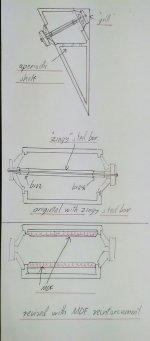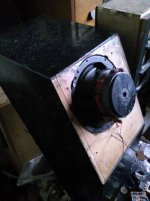Hi. I'm intrigued by a lot of the benefits of a full range and am considering diving in. I don't have a set chair in my listening space that is mine though, so would prefer something that doesn't have a laser beam sweet spot. Is the small sweet spot something that affects all full rangers, or are there designs/drivers that have wider dispersion.
So far, I've mostly been considering the Frugel Horn Mk3 with a MA Alpair driver, for no better reason than it's one of the first designs I looked into deeply (read, got obsessed with).
So far, I've mostly been considering the Frugel Horn Mk3 with a MA Alpair driver, for no better reason than it's one of the first designs I looked into deeply (read, got obsessed with).
Up to a point, it depends how you define it. Setting design technicalities aside for the moment, many wideband drive units have a rising axial response, partly because it tends to happen that way, partly out of deliberate design choice to provide greater off-axis output and improve the overall power response. So a good proportion are not actually intended to be listened to on-axis. Those with relatively shallow cones tend to have an advantage in this regard. It's unfortunate that few publish off-axis curves. MA & Fostex units tend to hold up well, some TB and Seas. Jordan at the pricier end also.
Hi. I'm intrigued by a lot of the benefits of a full range and am considering diving in. I don't have a set chair in my listening space that is mine though, so would prefer something that doesn't have a laser beam sweet spot. Is the small sweet spot something that affects all full rangers, or are there designs/drivers that have wider dispersion.
So far, I've mostly been considering the Frugel Horn Mk3 with a MA Alpair driver, for no better reason than it's one of the first designs I looked into deeply (read, got obsessed with).
Most full range drivers beam to some extend. This is clearly something i hear, no matter if i listen on axis or slightly of axis. We hear first arriving signal from speaker directly, but few milliseconds later we hear reflected bounced signal. If these are significantly different due to beaming, i hear it and it bothers me.
Good of axis behavior is important for long term non fatigue listening.
That's why i often add tweeter coaxially mounted to full range. Yes, its a departure from full range, but the result is better sound to me.
One more thing, you can eq on axis rising response, but that has no effect on beaming. You can never eq beaming.
Some full range drivers measured here.
Loudspeaker Raw Driver Measurements
My experience with Mark Audio drivers is that they don't beam that much, i often listen off axis or even not in front of the speakers (in the room next to where they stand) and never had the issue i had with some others i tried that beam more. The shallow cone of the mark audio does work very well on that.
And very big fullrange drivers beam way more than smaller ones, so maybe use a smaller driver. The Frugal Horn is made for 4" drivers like the Alpair 7MS so that would be a good one i think. I use the bigger Alpair 10.3 and CHN110 drivers.
And very big fullrange drivers beam way more than smaller ones, so maybe use a smaller driver. The Frugal Horn is made for 4" drivers like the Alpair 7MS so that would be a good one i think. I use the bigger Alpair 10.3 and CHN110 drivers.
As Sott suggests the amount of beaming will differ considerably across a representive cross-section of drivers.
A shallow cone will tend to have greater HF dispersion, a deep cone more beaming. The nature of the dustcap, and a whizzer if there is one will affect HF dispersion — note that to date i have found no whizzer cone drivers that benefit from phase plugs.
The holy grail of any FR is to have the radiating area of the cone of the driver gracefully shrinks as the outer edges are decoupled from the inner. No one has achieved this, but some do better than others. Tell-tell HF resonances are the evidence that this has not been achieved. If one gets these high enuff and high enuff Q there affects can be minimal (one sees this taken to extremes in things like beryllium and diamond tweeters).
A couple cases that illustrate that smallish changes can make a big difference. The Viatom B200 stock has a laser beam top end and as a consequence a significantlty rising response that lets Visaton spec the driver at 95dB. The B200 has a very deep, steep cone. Take the dustcap off and add a phase plug and the driver is transformed. Top becomes much better dispersed, the FR is dramatically flattened and the sensitivity becomes the real value of about 90 dB. At the other end of the spectrum we have the new MonoSuspension Mark Audios. In the larger 4 and 6” drivers actually extend out beyond the surround and curve back down to the surround. These have really good dispersion, as much from the trick suspension cones, but that cone has likely come close to the holey grail than any others.
It should be noted that, as a generalization, a smaller cone will have better disperison other thigs being equal (they rarely are).
With this in mind a WAW with a small FR like A5.2/3 crossed low to helper woofers can make for a speaker system that mskrd fre excuses.
dave
A shallow cone will tend to have greater HF dispersion, a deep cone more beaming. The nature of the dustcap, and a whizzer if there is one will affect HF dispersion — note that to date i have found no whizzer cone drivers that benefit from phase plugs.
The holy grail of any FR is to have the radiating area of the cone of the driver gracefully shrinks as the outer edges are decoupled from the inner. No one has achieved this, but some do better than others. Tell-tell HF resonances are the evidence that this has not been achieved. If one gets these high enuff and high enuff Q there affects can be minimal (one sees this taken to extremes in things like beryllium and diamond tweeters).
A couple cases that illustrate that smallish changes can make a big difference. The Viatom B200 stock has a laser beam top end and as a consequence a significantlty rising response that lets Visaton spec the driver at 95dB. The B200 has a very deep, steep cone. Take the dustcap off and add a phase plug and the driver is transformed. Top becomes much better dispersed, the FR is dramatically flattened and the sensitivity becomes the real value of about 90 dB. At the other end of the spectrum we have the new MonoSuspension Mark Audios. In the larger 4 and 6” drivers actually extend out beyond the surround and curve back down to the surround. These have really good dispersion, as much from the trick suspension cones, but that cone has likely come close to the holey grail than any others.
It should be noted that, as a generalization, a smaller cone will have better disperison other thigs being equal (they rarely are).
With this in mind a WAW with a small FR like A5.2/3 crossed low to helper woofers can make for a speaker system that mskrd fre excuses.
dave
Sort of related, but you will see a number of designs with 2 FRs, one firing forward and the other up, to the side, ot he back to increase the “room fill” of a pair of loudspeakers. The microTower Castle are a good example.
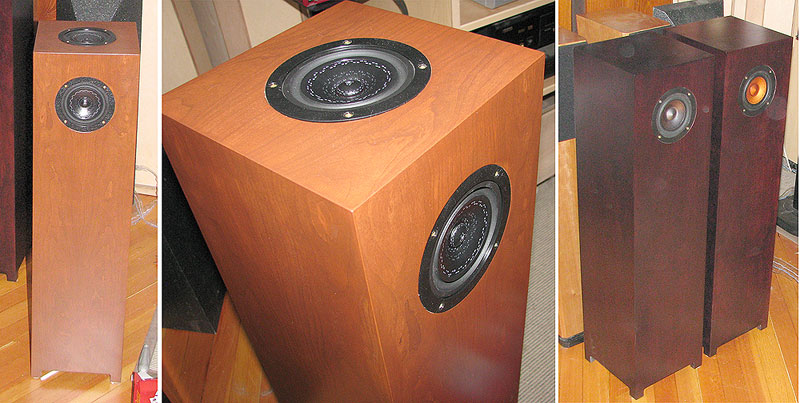
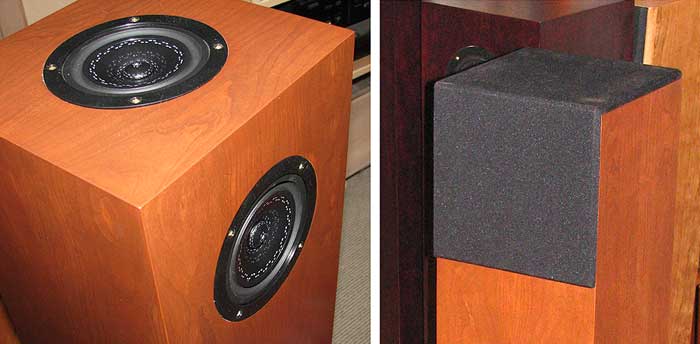
dave
dave
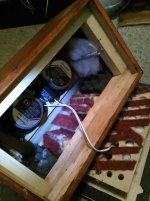
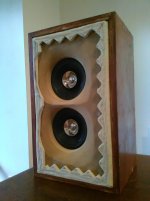
4 inches dia and above seems to be where dispersion problems start, I've sometimes got around it by using two full rangers with a small ( 1.5 uf approx ) cap in parallel with the bottom driver, with the drivers connected in series, so the upper has more treble than the lower one. Woven glass fibre drivers seem to have a lot of cone reduction, but this is just a guess.
Fountek 3”?
http://www.planet10-hifi.com/downloads/Dual-Driver-Wiring.pdf
The trick of series drivers with a shunt cap to create a (sort of) 1.5 way is underutilized. It is important to not push the XO too close to the driver resonance or it affects the response negatively.
dave
http://www.planet10-hifi.com/downloads/Dual-Driver-Wiring.pdf
The trick of series drivers with a shunt cap to create a (sort of) 1.5 way is underutilized. It is important to not push the XO too close to the driver resonance or it affects the response negatively.
dave
My limited experience of just 3X 4inch full-range drivers are as follows.
Fostex FE103en, listenable on axis but treble drops off-axis, very dry detailed sound maybe due to the lack of HF room reflections.
MA Pluvia 7, more lively sound compared to the Fostex, but hot on-axis either use a notch or listen off axis.
MA 7MS listenable both on and off axis, very pleased with this unit as a wideband with bass support. Has the detail of the Fostex but still maintains a lively top end. I listen to them in a large space which may affect the reflected sound that I perceive.
Fostex FE103en, listenable on axis but treble drops off-axis, very dry detailed sound maybe due to the lack of HF room reflections.
MA Pluvia 7, more lively sound compared to the Fostex, but hot on-axis either use a notch or listen off axis.
MA 7MS listenable both on and off axis, very pleased with this unit as a wideband with bass support. Has the detail of the Fostex but still maintains a lively top end. I listen to them in a large space which may affect the reflected sound that I perceive.
If we are talking about a 2-3" FR driver combined with a woofer, then the sweet spot can be made comparable to a normal speaker.
With a larger FR driver then the speaker will be more directional at higher frequencies.
The main benefit of FR as I see is with a FAST setup, so kind of like a 2-way but with a FR driver instead of a tweeter and a much lower crossover point. Thus we can avoid the problematic 1-3 khz range where the ear is the most sensitive. It is also easy to get a really good integration since you can avoid lobing.
With a larger FR driver then the speaker will be more directional at higher frequencies.
The main benefit of FR as I see is with a FAST setup, so kind of like a 2-way but with a FR driver instead of a tweeter and a much lower crossover point. Thus we can avoid the problematic 1-3 khz range where the ear is the most sensitive. It is also easy to get a really good integration since you can avoid lobing.
I always drool a bit when Dave shows off the Castle pics, as I find I'm liking the sound of an upward-firing driver. 4 drivers though, so I've been experimenting with 2 and a way to reflect part of the sound forward, vs all of it going up.
If you're after a proven design, versus DIYing "a small FR crossed low to a helper woofer", I'd bet those Castles would do what you want.
If you're after a proven design, versus DIYing "a small FR crossed low to a helper woofer", I'd bet those Castles would do what you want.
The main benefit of FR as I see is with a FAST setup, so kind of like a 2-way but with a FR driver instead of a tweeter and a much lower crossover point.
+1
Being able to do away with crossovers is good.
Save on complexity, weight and money.
I use a pair of Fane 12-250TC's in a sealed box and get good results.
Save on complexity, weight and money.
I use a pair of Fane 12-250TC's in a sealed box and get good results.
Being able to do away with crossovers is good.
Save on complexity, weight and money.
I use a pair of Fane 12-250TC's in a sealed box and get good results.
Hi,
it is important to remember that everything is a compromise. Savings on cost (complexity, weight and money) indicate the trade-off is in the aesthetics and/or audio quality 😉
3" FR driver would beam above ~4kHz which seems to be the largest driver one would want to go in this regard if staying away from problems in the "important zone", the speech. 3" driver doesn't provide any bass though. Single FR driver speakers the treble or bass or both are compromised because of physics, wavelengths are long at bass and short at treble. Driver can't be big and small at the same time. Multiway speakers address this but with added cost (complexity, weight, money). This is compromise taken for audio quality, not against it. FAST seems to be a good concept.
Last edited:
Thanks for all the helpful replies. I'm pretty intrigued by the micro tower castles mentioned above. When I looked at the plans, it mentioned needing 11 feet of breathing space though, which I don't have. Is that just for the bipole set up, or do ones with the upward facing driver need similar?
Also, is there any experience of the alpair 7MS in them? Couldn't find mich about that.
Also, is there any experience of the alpair 7MS in them? Couldn't find mich about that.
Some mythbusting
Full range speakers often don't need electrical filters/cross-overs.
But that doesn't mean they don't have filters build in.
Mechanical and accoustic filters have the exact same impact on the frequency response, use the same math to calculate them and sound the same as their electrical counterparts.
Replacing electrical filters with mechanical and acoustical filters, as is the case with many full range speakers, doesn't mean you have no filters in the signal path.
And as a matter of fact, full range speakers often have much more filters in their signal path, just take a look at their frequency curve. If a speaker has no filters, it must be ruler flat in a reflection free enviroment, no such speakers exist.
Being able to do away with crossovers is good.
Save on complexity, weight and money.
Full range speakers often don't need electrical filters/cross-overs.
But that doesn't mean they don't have filters build in.
Mechanical and accoustic filters have the exact same impact on the frequency response, use the same math to calculate them and sound the same as their electrical counterparts.
Replacing electrical filters with mechanical and acoustical filters, as is the case with many full range speakers, doesn't mean you have no filters in the signal path.
And as a matter of fact, full range speakers often have much more filters in their signal path, just take a look at their frequency curve. If a speaker has no filters, it must be ruler flat in a reflection free enviroment, no such speakers exist.
...needing 11 feet of breathing space though...
Not sure where that came from, i would ignore it.
the alpair 7MS in them?
AFAIK that has not been done yet.
dave
full range speakers often have much more filters in their signal path
To date, of the many, many, many FR boxes we have built, one, just one, used a filter. They were $10 each 8” whizzer cone drivers.
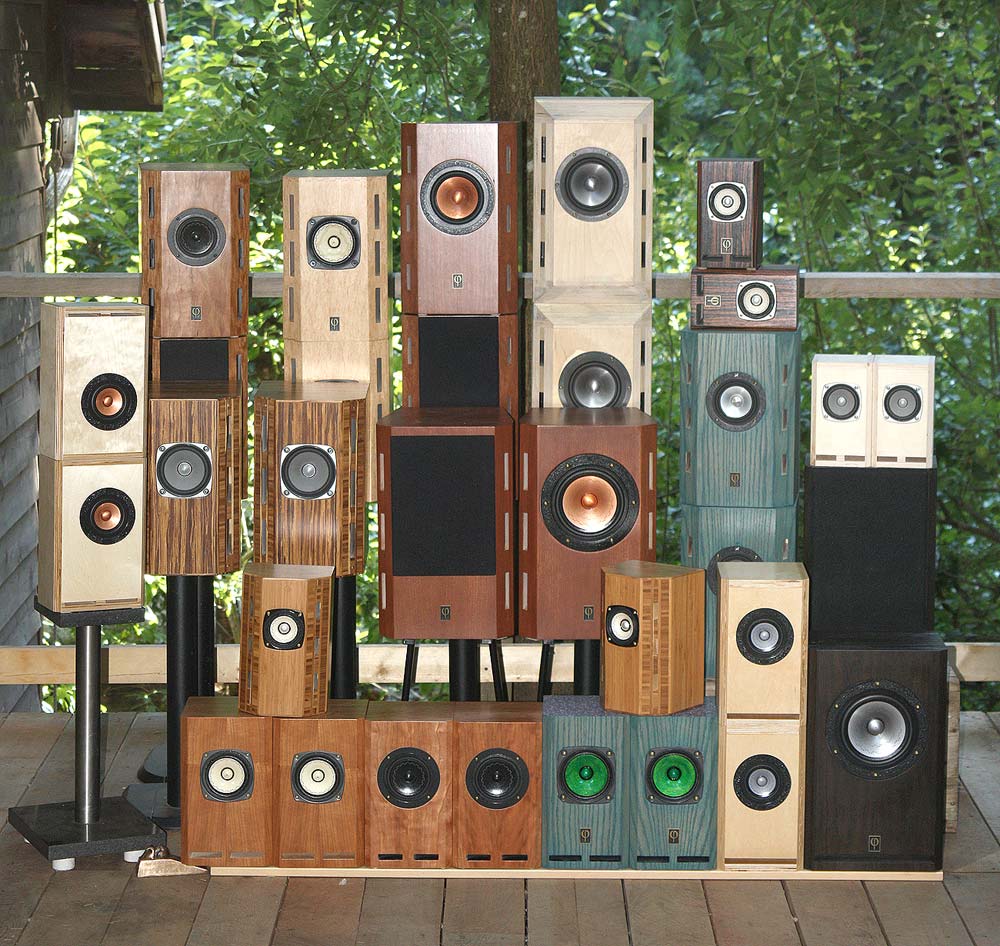
(just a small sample)
dave
'Filter' in usual nomanclature implies a component, be it electrical or mechanical, that is specifically added, or incorporated to modify the frequency, impedance or phase response from a given baseline it started out from. Most wideband drive units that I know of do not incorporate such components. Their physical design by definition affects behaviour, so technically you could call any and every component in a drive unit a 'filter' but to do so would be stretching the term to pure linguistic semantics. What it is certainly accurate to say is that moving coil wideband drive units all have crossovers to some extent, since much of their BW is produced through TL behaviour in the cone / sub-emitting structures -they just happen to be mechanical rather than electrical.
- Home
- Loudspeakers
- Full Range
- Directivity of FR drivers
